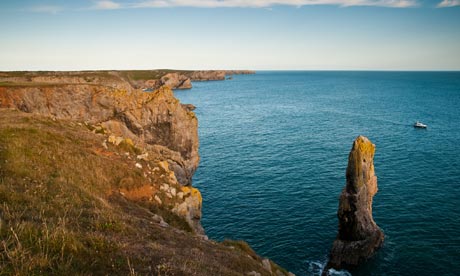
Atlantic gales make winter the most exhilarating time to step out in west Wales, says local Alf Alderson
Don’t shy away from encroaching winter: embrace the cold and tempestuous weather by wrapping up and facing the elements. And there’s nowhere better to chase a few storms this November than the vigorous coastline of west Wales.
The Pembrokeshire coast faces the full force of the Atlantic and endures, on average, more than 30 gales a year. And at St David’s Head the powerful ocean currents and tidal races churn up the water into an even greater maelstrom.
Swells often roll over the top of the 20m-high headland, while the sea spray from massive waves colliding with the cliffs can be flung more than 30m in the air. I’ve been on the nearby beach at Whitesands Bay in storm-force winds (more than 88km/h) and seen small adults lifted off their feet, cars blown uphill and a static six-berth caravan tossed over a wall.
Start your storm-chasing by checking the BBC weather forecast for nearby Milford Haven – good storm chasing/walking weather will have winds in the range of 51-75km/h; winds over 63km/h indicate a gale. Beyond 76km/h you’re into a ‘severe gale’ or worse, and there’s the danger of literally being blown off your feet or hit by wind-blown objects.
Once you’ve picked a suitable stormy weekend, grab your boots and waterproofs and head for St David’s, Britain’s smallest city and the perfect base for windswept wanderings. Start with a warming coffee at The Pebbles café, then head down to Whitesands Bay, a couple of miles from St David’s and a pleasant walk on the back roads via the city’s 12th century cathedral and the Bishop’s Palace, a splendid and stately ruin.
Once at the beach, follow the coast path north-west for 1.6km out to St David’s Head. From its safe ramparts you can look south-west to Ramsey Island, a RSPB reserve, and spot many islets, which have been responsible for sinking several vessels, including the St David’s lifeboat in 1911. Retrace your steps back to Whitesands, or detour to the summit of Carn Llidi – at 182m it has sensational views across Pembrokeshire and out to sea.
The walk from Whitesands Bay is 3km; the detour to Carn Llidi less than 2km. But walking against the wind is tough and watching the storm-tossed waves beat against the cliffs can be mesmerising – allow the best part of a day.
The day after a storm conditions are often sunny with blustery north-westerly winds – ideal for longer coastal walks, kite-flying on the beach or surfing if the swell isn’t too strong (gear can be hired locally and surf lessons are available at Whitesands Surf School). If you walk back up to the summit of Carn Llidi you may even see all the way across to Ireland’s Wicklow Mountains.
A gale is defined as winds between 5km/h and 75km/h on land – anything above this strength and you'll have serious difficulty staying on your feet.
Use common sense – if the wind is so strong you can barely walk into it, stay on the beach and away from sea cliffs.
Watch out for waves while standing on headlands and beaches.
Check tides times and ensure there's no danger of getting trapped by rising tides.
Give all your waterproofs a rinse in fresh water after your walk to get the salt spray out.
The nearest railway station is Haverfordwest, 24km east of St David's. From there the Richard Brothers' 342 bus will take you to the city. Drivers should head towards west Wales, following signs for Swansea, Carmarthen, then Haverfordwest; from there take the A487 to St David's.
Stay at the Old Cross Hotel located right in the centre of St Davids. Double rooms, including breakfast, in low season start from £72 a night.
The only pub in St David's is the Farmer's Arms on Goat Street – easy enough to find and populated by nearly everyone from local lifeboat men to surfers.
Back to Discover Wales